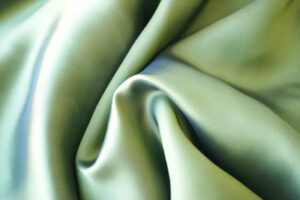Cupro is a semi-synthetic fibre made from the cotton plant. Its luxurious feel makes it a perfect choice for summer clothing items such as skirts, dresses and blouses.
Cupro is a synthetic cellulose fibre derived from Linter Cotton (or Cotton waste) that has been treated with cuprammonium. The cellulose is soaked in a chemical solution called “cuprammonium” to produce the yarn (hence the name).
The fabric is biodegradable, making it a viable, more eco-friendly option than viscose.
What is cupro, and where does it come from
Cupro is a fibre that was created in the 1900s in Germany and is also known as “Bemberg” (from J.P. Bemberg, who improved the initial formula developed by Swiss chemist Matthias Eduard Schweizer in 1890), “ammonia silk,” or “cuprammonium rayon”.
Cupro is a plant-based material chemically treated to create the resulting fabric, much like Tencel and Modal.
Cupro is considered to have all the benefits of silk: it’s silky-smooth and drapes like natural silk. As a result, it is a popular choice for clothing items.
It is a cotton “regenerated cellulose” fabric, essentially made of cotton waste (pre-consumer cotton). It’s composed of tiny silky cotton fibres, known as linter. Linter protrudes from the cottonseed and is too small to be spun. Then, the linter is put into a cuprammonium solution, containing copper and ammonium. It’s then spun into fibres when dropped into caustic soda:
- Exposing: cuprammonium rayon is made by exposing the cellulose of a plant product (linter in our case) to a mixture of ammonium and copper
- Combining: these two elements combine with the cellulose to make a new substance
- Dropping: the mixture is dropped into caustic soda and extruded through a spinneret
- Reconstructing: the extruded strings are immersed into a series of hardening baths that reconstruct the cellulose and remove the ammonia, copper and caustic sauda
Is cupro sustainable?
The answer to this question is a little more complicated than a simple yes or no. Cupro is made from the cotton plant, which is a natural fibre. It is also biodegradable, making it a good choice for those who care about the planet. However, it is not as sustainable as some other fabrics, such as Tencel and Modal, which are made from sustainably sourced materials. Cupro is also not as durable as some other fabrics, so it may not be the best choice for items that must be washed frequently.
In some ways, yes…
Cupro is a recycled textile since it results from the cotton processing process. We all know that cotton production is a very wasteful and energy-intensive procedure (hence the importance of the use of recycled cotton). It requires a large amount of water and pesticides when not organic. So using every last bit of the cotton plant helps to minimize waste.
Cupro is vegan and cruelty-free, unlike silk, which comes from insect cocoons. It’s also machine washable, which is more eco-friendly than dry cleaning delicate silk items.
…but not really
Although cuprammonium rayon has several advantages, there’s no denying that it is created with toxic chemicals that can harm people and the environment unless properly disposed of. Although the chemical baths are used multiple times, they must ultimately be eliminated somewhere.
Like all other synthetic textiles, China is the world’s major producer of cuprammonium rayon. Despite environmental concerns linked with cuprammonium rayon manufacturing, China delivers tons of “cupro” to Western nations every year.
As Sewport (sourcing expert) mentioned, “China’s synthetic textile factories are reviled around the world as havens for modern-day slave labour.” Despite the environmental and human concerns associated with cupro production, “China continues to export tons of cupro to Western nations every year.”
Cupro fabric does not have any certifications, and its production has even been forbidden in the United States “due to the inability of producers to comply with fundamental air and water protection standards.”
Conclusion
So while cupro is technically a recycled and cruelty-free alternative to silk, it’s not strictly ethical and sustainable.
Despite being recycled, cuprammonium rayon significantly negatively impacts the environment. Unfortunately, manufacturers of cupro and similar textiles are simply attempting to figure out how to make money with waste materials rather than searching for ways to solve environmental problems.
Over time, China has accumulated the world’s waste at a meagre cost, and Beijing lab scientists have worked tirelessly to find new applications for this trash. Copper, ammonia, and caustic soda are all inexpensive, and the cupro process itself is simple to execute.

